Building and Construction: Yorkshire Brewery Demolition Report
VerifiedAdded on 2022/10/06
|15
|1761
|15
Report
AI Summary
This report details the commercial demolition of the Yorkshire Brewery (14-21 Robert Street, Collingwood), addressing various aspects of the project. The report begins with a site map and description, followed by a historical overview of the site and its surroundings. It outlines council requirements concerning the environment, benchmarking criteria, and potential areas of risk. The report identifies key stakeholders involved in the demolition process, including engineers, safety officers, and environmental officers, and describes the communication paths among them. It also covers methods for collecting and evaluating environmental data and discusses potential site contamination issues. The demolition was conducted in strict adherence to ISO 14001 and Australian demolition codes. The report provides a comprehensive overview of the demolition process, including stakeholder management, environmental considerations, and data collection methods.
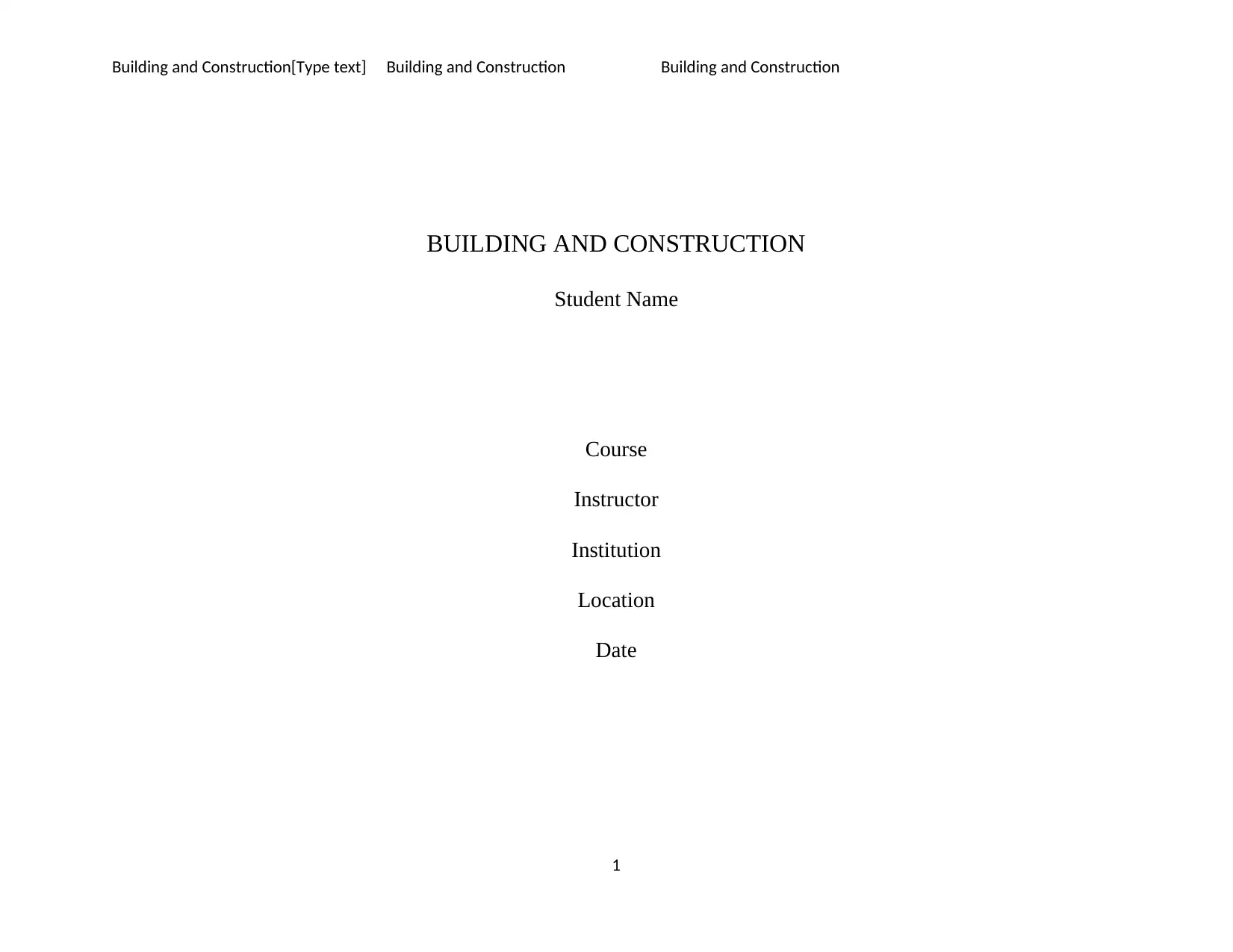
Building and Construction[Type text] Building and Construction Building and Construction
BUILDING AND CONSTRUCTION
Student Name
Course
Instructor
Institution
Location
Date
1
BUILDING AND CONSTRUCTION
Student Name
Course
Instructor
Institution
Location
Date
1
Paraphrase This Document
Need a fresh take? Get an instant paraphrase of this document with our AI Paraphraser
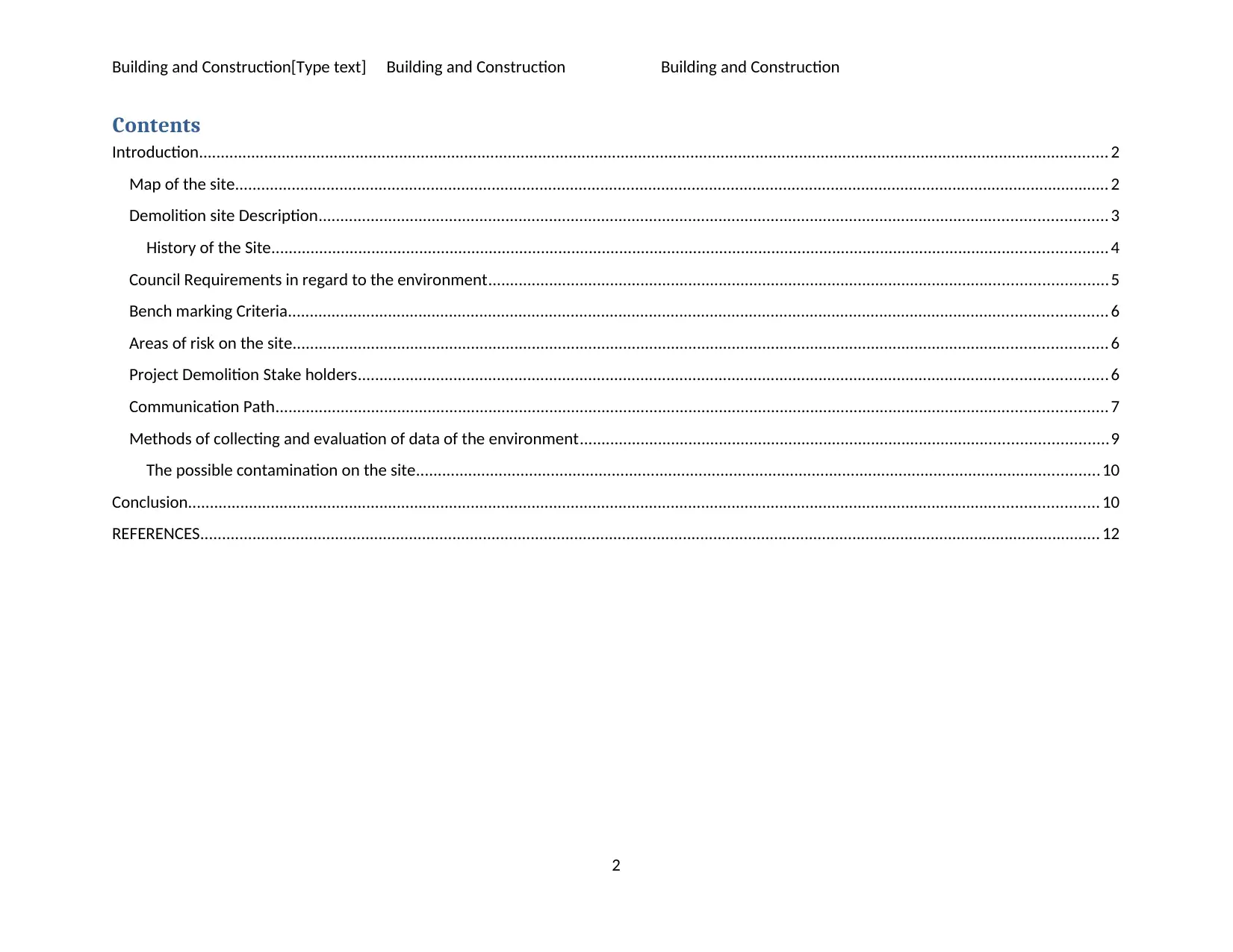
Building and Construction[Type text] Building and Construction Building and Construction
Contents
Introduction................................................................................................................................................................................................................. 2
Map of the site......................................................................................................................................................................................................... 2
Demolition site Description..................................................................................................................................................................................... 3
History of the Site................................................................................................................................................................................................ 4
Council Requirements in regard to the environment..............................................................................................................................................5
Bench marking Criteria............................................................................................................................................................................................ 6
Areas of risk on the site........................................................................................................................................................................................... 6
Project Demolition Stake holders............................................................................................................................................................................ 6
Communication Path............................................................................................................................................................................................... 7
Methods of collecting and evaluation of data of the environment.........................................................................................................................9
The possible contamination on the site.............................................................................................................................................................10
Conclusion................................................................................................................................................................................................................. 10
REFERENCES............................................................................................................................................................................................................... 12
2
Contents
Introduction................................................................................................................................................................................................................. 2
Map of the site......................................................................................................................................................................................................... 2
Demolition site Description..................................................................................................................................................................................... 3
History of the Site................................................................................................................................................................................................ 4
Council Requirements in regard to the environment..............................................................................................................................................5
Bench marking Criteria............................................................................................................................................................................................ 6
Areas of risk on the site........................................................................................................................................................................................... 6
Project Demolition Stake holders............................................................................................................................................................................ 6
Communication Path............................................................................................................................................................................................... 7
Methods of collecting and evaluation of data of the environment.........................................................................................................................9
The possible contamination on the site.............................................................................................................................................................10
Conclusion................................................................................................................................................................................................................. 10
REFERENCES............................................................................................................................................................................................................... 12
2
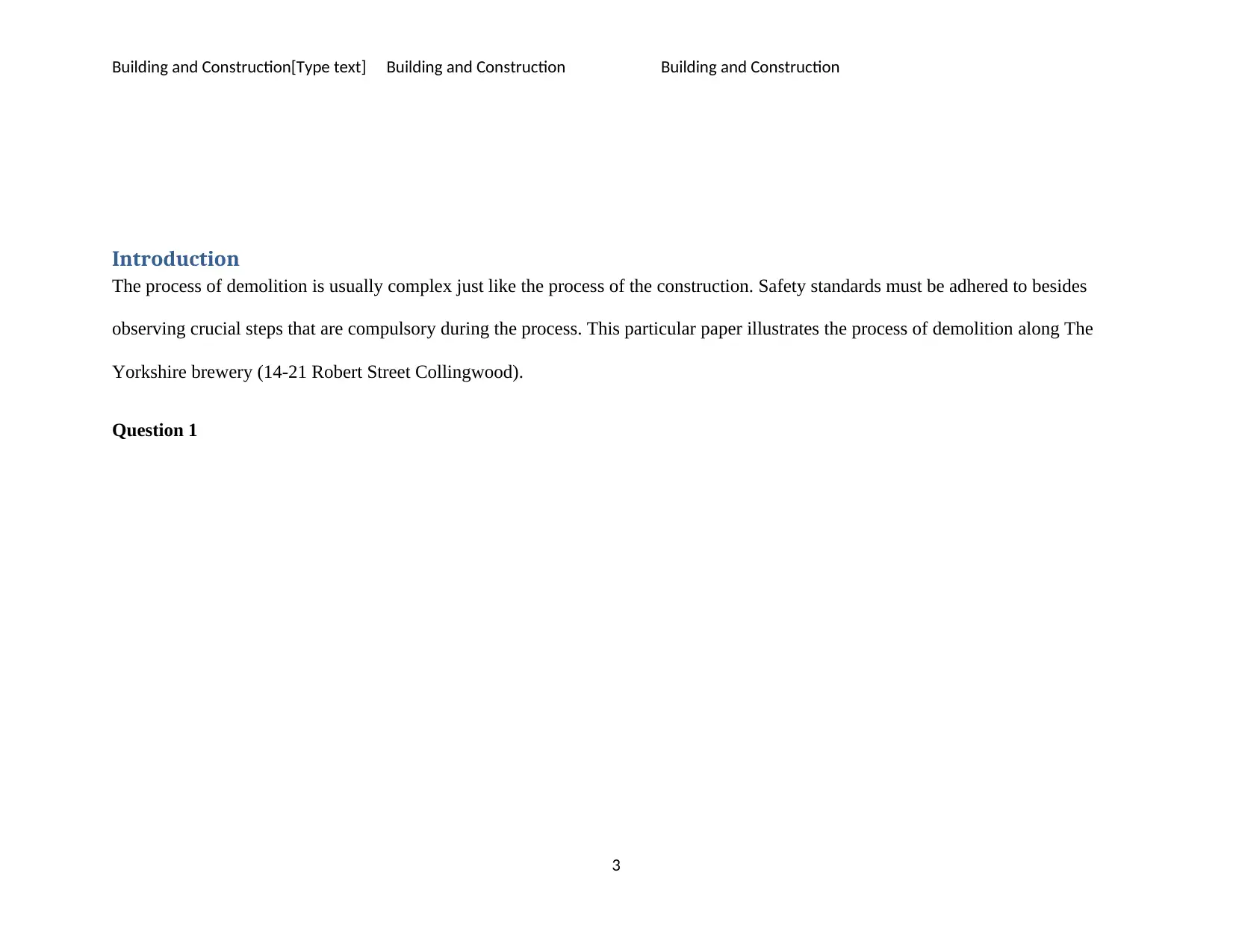
Building and Construction[Type text] Building and Construction Building and Construction
Introduction
The process of demolition is usually complex just like the process of the construction. Safety standards must be adhered to besides
observing crucial steps that are compulsory during the process. This particular paper illustrates the process of demolition along The
Yorkshire brewery (14-21 Robert Street Collingwood).
Question 1
3
Introduction
The process of demolition is usually complex just like the process of the construction. Safety standards must be adhered to besides
observing crucial steps that are compulsory during the process. This particular paper illustrates the process of demolition along The
Yorkshire brewery (14-21 Robert Street Collingwood).
Question 1
3
⊘ This is a preview!⊘
Do you want full access?
Subscribe today to unlock all pages.

Trusted by 1+ million students worldwide
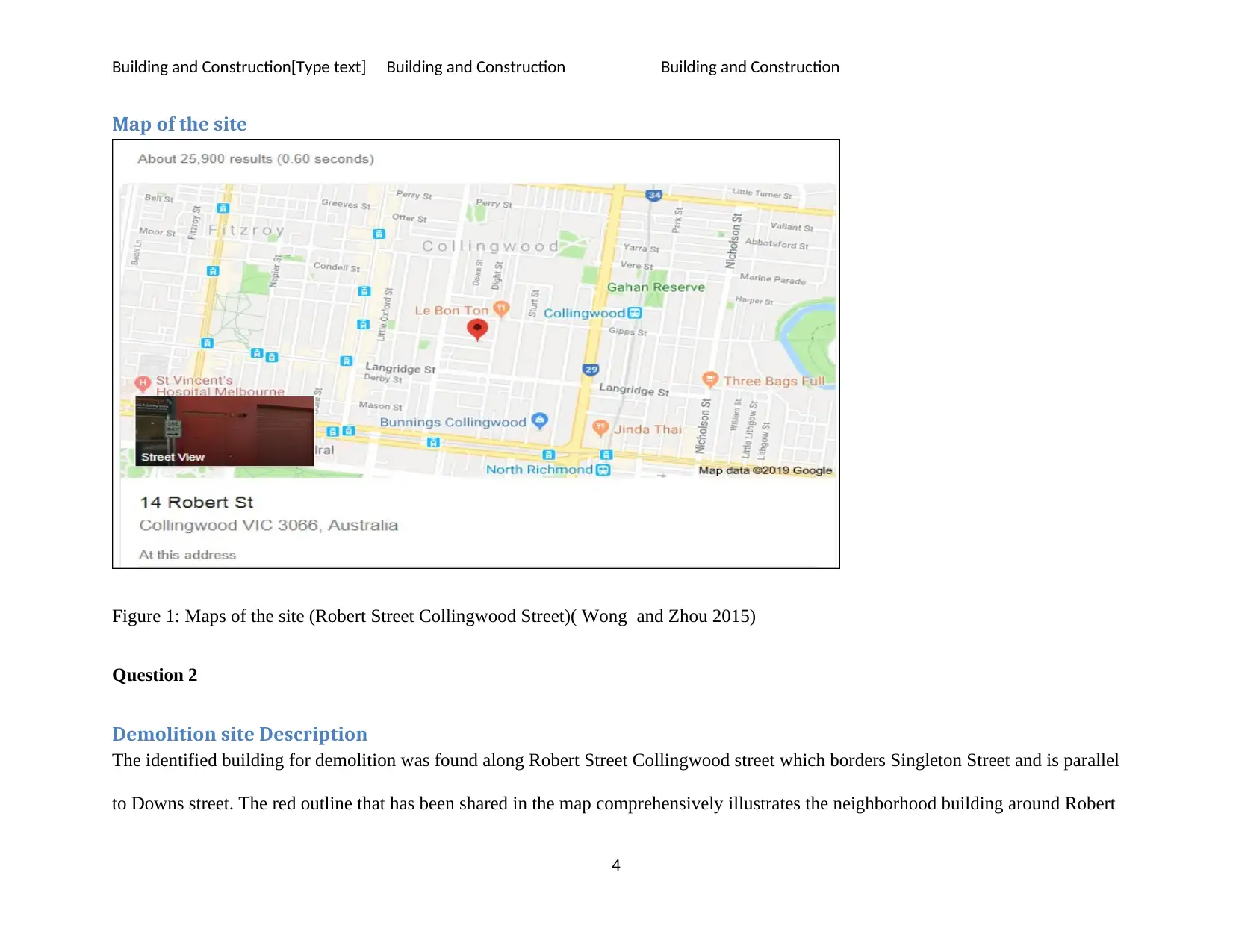
Building and Construction[Type text] Building and Construction Building and Construction
Map of the site
Figure 1: Maps of the site (Robert Street Collingwood Street)( Wong and Zhou 2015)
Question 2
Demolition site Description
The identified building for demolition was found along Robert Street Collingwood street which borders Singleton Street and is parallel
to Downs street. The red outline that has been shared in the map comprehensively illustrates the neighborhood building around Robert
4
Map of the site
Figure 1: Maps of the site (Robert Street Collingwood Street)( Wong and Zhou 2015)
Question 2
Demolition site Description
The identified building for demolition was found along Robert Street Collingwood street which borders Singleton Street and is parallel
to Downs street. The red outline that has been shared in the map comprehensively illustrates the neighborhood building around Robert
4
Paraphrase This Document
Need a fresh take? Get an instant paraphrase of this document with our AI Paraphraser
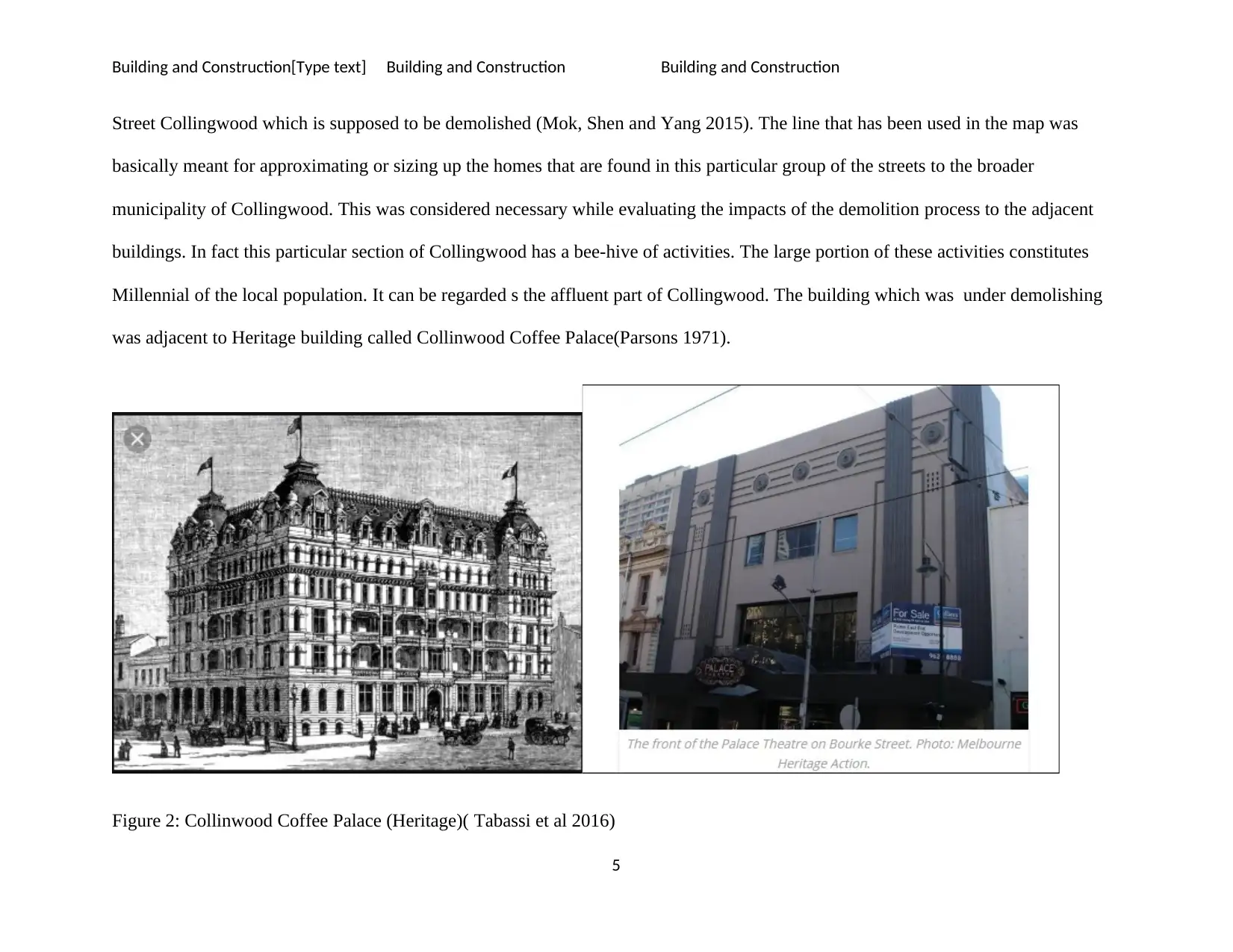
Building and Construction[Type text] Building and Construction Building and Construction
Street Collingwood which is supposed to be demolished (Mok, Shen and Yang 2015). The line that has been used in the map was
basically meant for approximating or sizing up the homes that are found in this particular group of the streets to the broader
municipality of Collingwood. This was considered necessary while evaluating the impacts of the demolition process to the adjacent
buildings. In fact this particular section of Collingwood has a bee-hive of activities. The large portion of these activities constitutes
Millennial of the local population. It can be regarded s the affluent part of Collingwood. The building which was under demolishing
was adjacent to Heritage building called Collinwood Coffee Palace(Parsons 1971).
Figure 2: Collinwood Coffee Palace (Heritage)( Tabassi et al 2016)
5
Street Collingwood which is supposed to be demolished (Mok, Shen and Yang 2015). The line that has been used in the map was
basically meant for approximating or sizing up the homes that are found in this particular group of the streets to the broader
municipality of Collingwood. This was considered necessary while evaluating the impacts of the demolition process to the adjacent
buildings. In fact this particular section of Collingwood has a bee-hive of activities. The large portion of these activities constitutes
Millennial of the local population. It can be regarded s the affluent part of Collingwood. The building which was under demolishing
was adjacent to Heritage building called Collinwood Coffee Palace(Parsons 1971).
Figure 2: Collinwood Coffee Palace (Heritage)( Tabassi et al 2016)
5
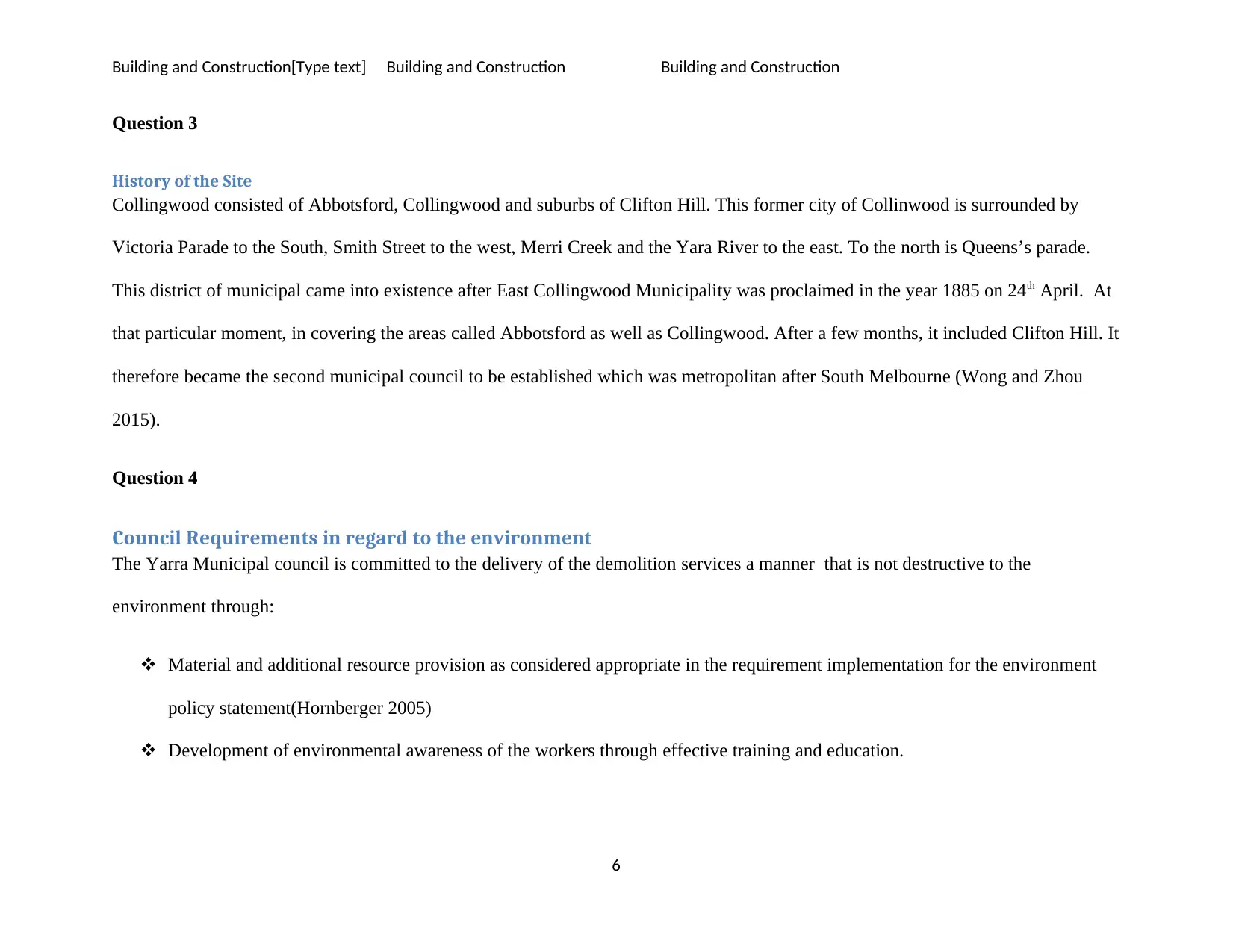
Building and Construction[Type text] Building and Construction Building and Construction
Question 3
History of the Site
Collingwood consisted of Abbotsford, Collingwood and suburbs of Clifton Hill. This former city of Collinwood is surrounded by
Victoria Parade to the South, Smith Street to the west, Merri Creek and the Yara River to the east. To the north is Queens’s parade.
This district of municipal came into existence after East Collingwood Municipality was proclaimed in the year 1885 on 24th April. At
that particular moment, in covering the areas called Abbotsford as well as Collingwood. After a few months, it included Clifton Hill. It
therefore became the second municipal council to be established which was metropolitan after South Melbourne (Wong and Zhou
2015).
Question 4
Council Requirements in regard to the environment
The Yarra Municipal council is committed to the delivery of the demolition services a manner that is not destructive to the
environment through:
Material and additional resource provision as considered appropriate in the requirement implementation for the environment
policy statement(Hornberger 2005)
Development of environmental awareness of the workers through effective training and education.
6
Question 3
History of the Site
Collingwood consisted of Abbotsford, Collingwood and suburbs of Clifton Hill. This former city of Collinwood is surrounded by
Victoria Parade to the South, Smith Street to the west, Merri Creek and the Yara River to the east. To the north is Queens’s parade.
This district of municipal came into existence after East Collingwood Municipality was proclaimed in the year 1885 on 24th April. At
that particular moment, in covering the areas called Abbotsford as well as Collingwood. After a few months, it included Clifton Hill. It
therefore became the second municipal council to be established which was metropolitan after South Melbourne (Wong and Zhou
2015).
Question 4
Council Requirements in regard to the environment
The Yarra Municipal council is committed to the delivery of the demolition services a manner that is not destructive to the
environment through:
Material and additional resource provision as considered appropriate in the requirement implementation for the environment
policy statement(Hornberger 2005)
Development of environmental awareness of the workers through effective training and education.
6
⊘ This is a preview!⊘
Do you want full access?
Subscribe today to unlock all pages.

Trusted by 1+ million students worldwide
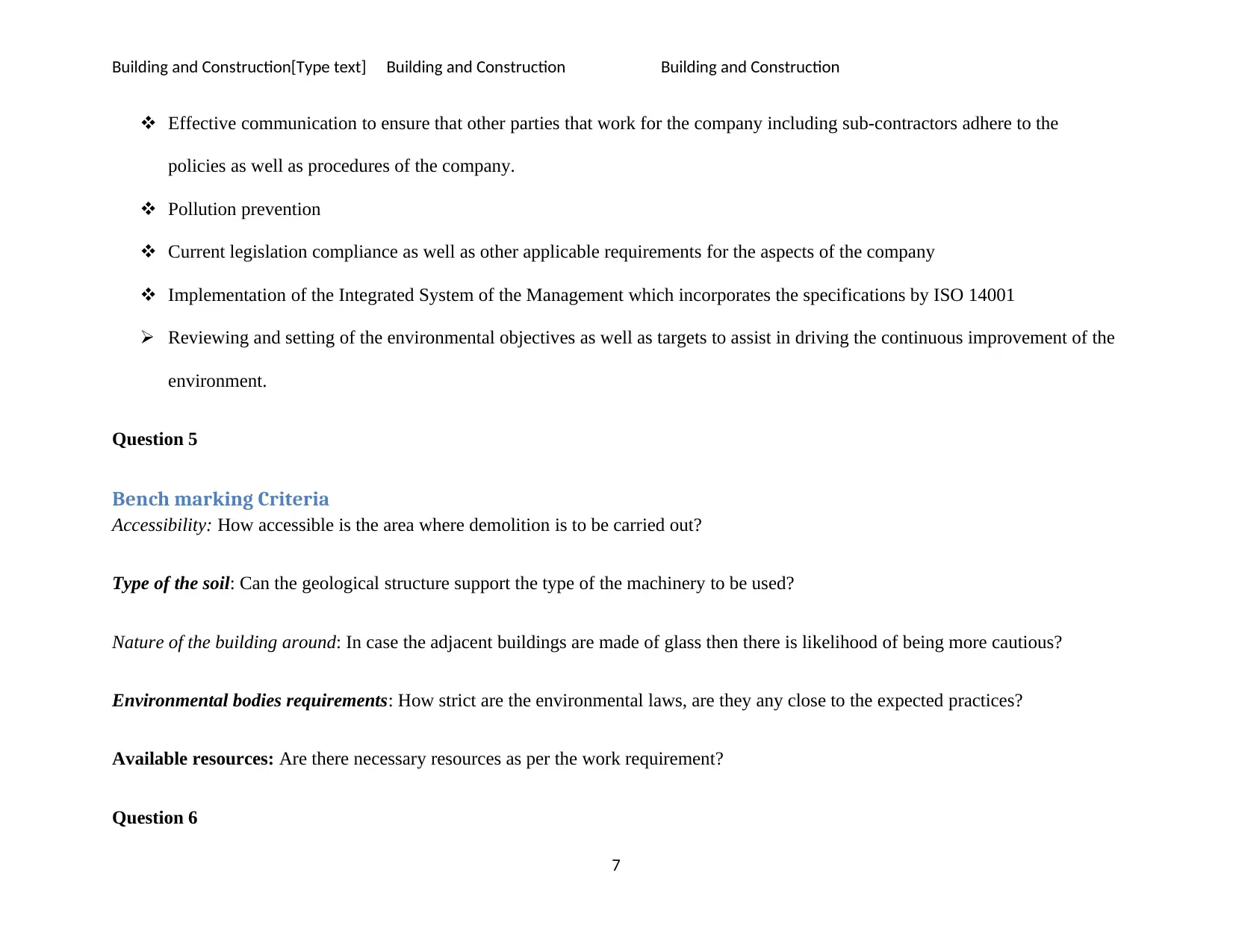
Building and Construction[Type text] Building and Construction Building and Construction
Effective communication to ensure that other parties that work for the company including sub-contractors adhere to the
policies as well as procedures of the company.
Pollution prevention
Current legislation compliance as well as other applicable requirements for the aspects of the company
Implementation of the Integrated System of the Management which incorporates the specifications by ISO 14001
Reviewing and setting of the environmental objectives as well as targets to assist in driving the continuous improvement of the
environment.
Question 5
Bench marking Criteria
Accessibility: How accessible is the area where demolition is to be carried out?
Type of the soil: Can the geological structure support the type of the machinery to be used?
Nature of the building around: In case the adjacent buildings are made of glass then there is likelihood of being more cautious?
Environmental bodies requirements: How strict are the environmental laws, are they any close to the expected practices?
Available resources: Are there necessary resources as per the work requirement?
Question 6
7
Effective communication to ensure that other parties that work for the company including sub-contractors adhere to the
policies as well as procedures of the company.
Pollution prevention
Current legislation compliance as well as other applicable requirements for the aspects of the company
Implementation of the Integrated System of the Management which incorporates the specifications by ISO 14001
Reviewing and setting of the environmental objectives as well as targets to assist in driving the continuous improvement of the
environment.
Question 5
Bench marking Criteria
Accessibility: How accessible is the area where demolition is to be carried out?
Type of the soil: Can the geological structure support the type of the machinery to be used?
Nature of the building around: In case the adjacent buildings are made of glass then there is likelihood of being more cautious?
Environmental bodies requirements: How strict are the environmental laws, are they any close to the expected practices?
Available resources: Are there necessary resources as per the work requirement?
Question 6
7
Paraphrase This Document
Need a fresh take? Get an instant paraphrase of this document with our AI Paraphraser
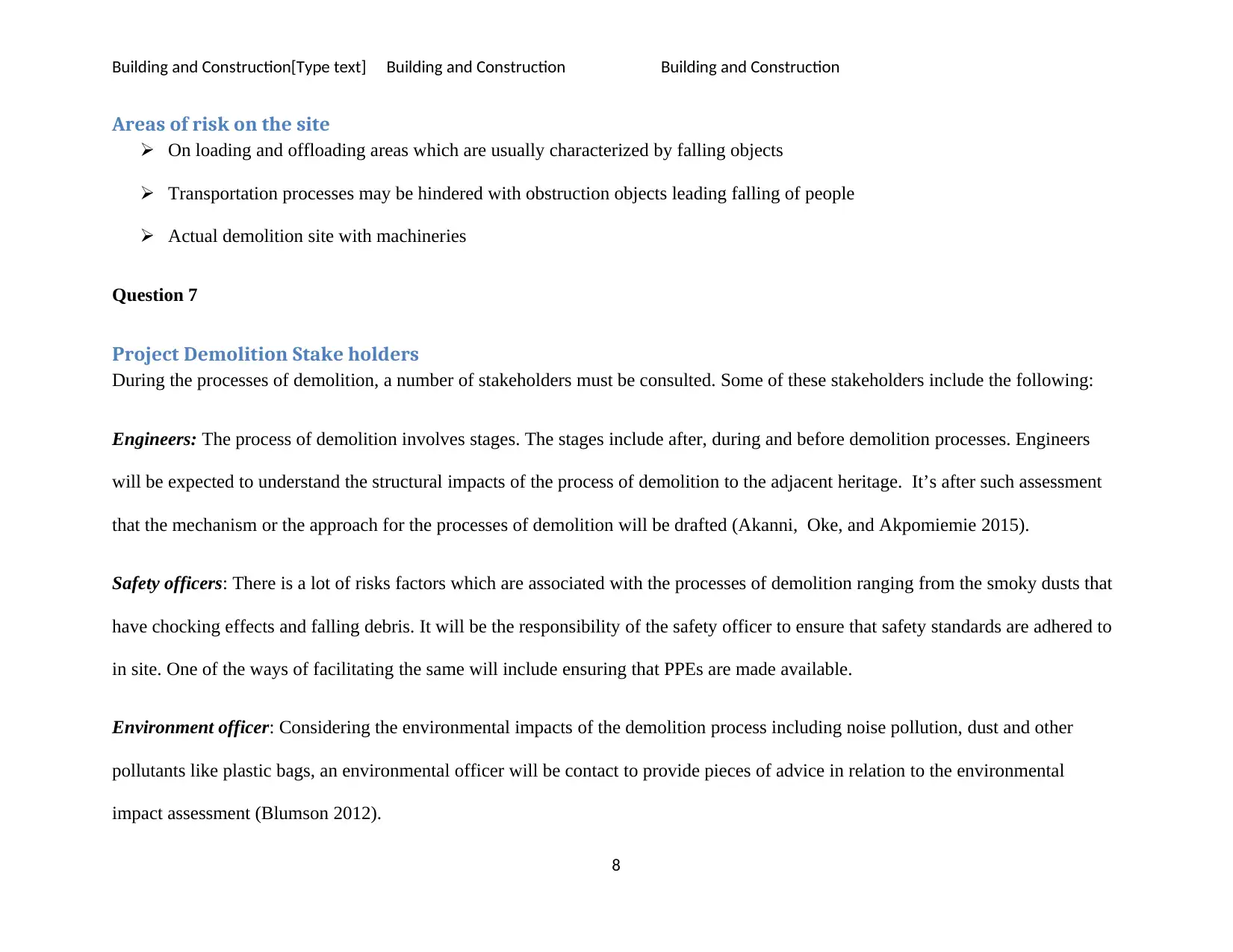
Building and Construction[Type text] Building and Construction Building and Construction
Areas of risk on the site
On loading and offloading areas which are usually characterized by falling objects
Transportation processes may be hindered with obstruction objects leading falling of people
Actual demolition site with machineries
Question 7
Project Demolition Stake holders
During the processes of demolition, a number of stakeholders must be consulted. Some of these stakeholders include the following:
Engineers: The process of demolition involves stages. The stages include after, during and before demolition processes. Engineers
will be expected to understand the structural impacts of the process of demolition to the adjacent heritage. It’s after such assessment
that the mechanism or the approach for the processes of demolition will be drafted (Akanni, Oke, and Akpomiemie 2015).
Safety officers: There is a lot of risks factors which are associated with the processes of demolition ranging from the smoky dusts that
have chocking effects and falling debris. It will be the responsibility of the safety officer to ensure that safety standards are adhered to
in site. One of the ways of facilitating the same will include ensuring that PPEs are made available.
Environment officer: Considering the environmental impacts of the demolition process including noise pollution, dust and other
pollutants like plastic bags, an environmental officer will be contact to provide pieces of advice in relation to the environmental
impact assessment (Blumson 2012).
8
Areas of risk on the site
On loading and offloading areas which are usually characterized by falling objects
Transportation processes may be hindered with obstruction objects leading falling of people
Actual demolition site with machineries
Question 7
Project Demolition Stake holders
During the processes of demolition, a number of stakeholders must be consulted. Some of these stakeholders include the following:
Engineers: The process of demolition involves stages. The stages include after, during and before demolition processes. Engineers
will be expected to understand the structural impacts of the process of demolition to the adjacent heritage. It’s after such assessment
that the mechanism or the approach for the processes of demolition will be drafted (Akanni, Oke, and Akpomiemie 2015).
Safety officers: There is a lot of risks factors which are associated with the processes of demolition ranging from the smoky dusts that
have chocking effects and falling debris. It will be the responsibility of the safety officer to ensure that safety standards are adhered to
in site. One of the ways of facilitating the same will include ensuring that PPEs are made available.
Environment officer: Considering the environmental impacts of the demolition process including noise pollution, dust and other
pollutants like plastic bags, an environmental officer will be contact to provide pieces of advice in relation to the environmental
impact assessment (Blumson 2012).
8
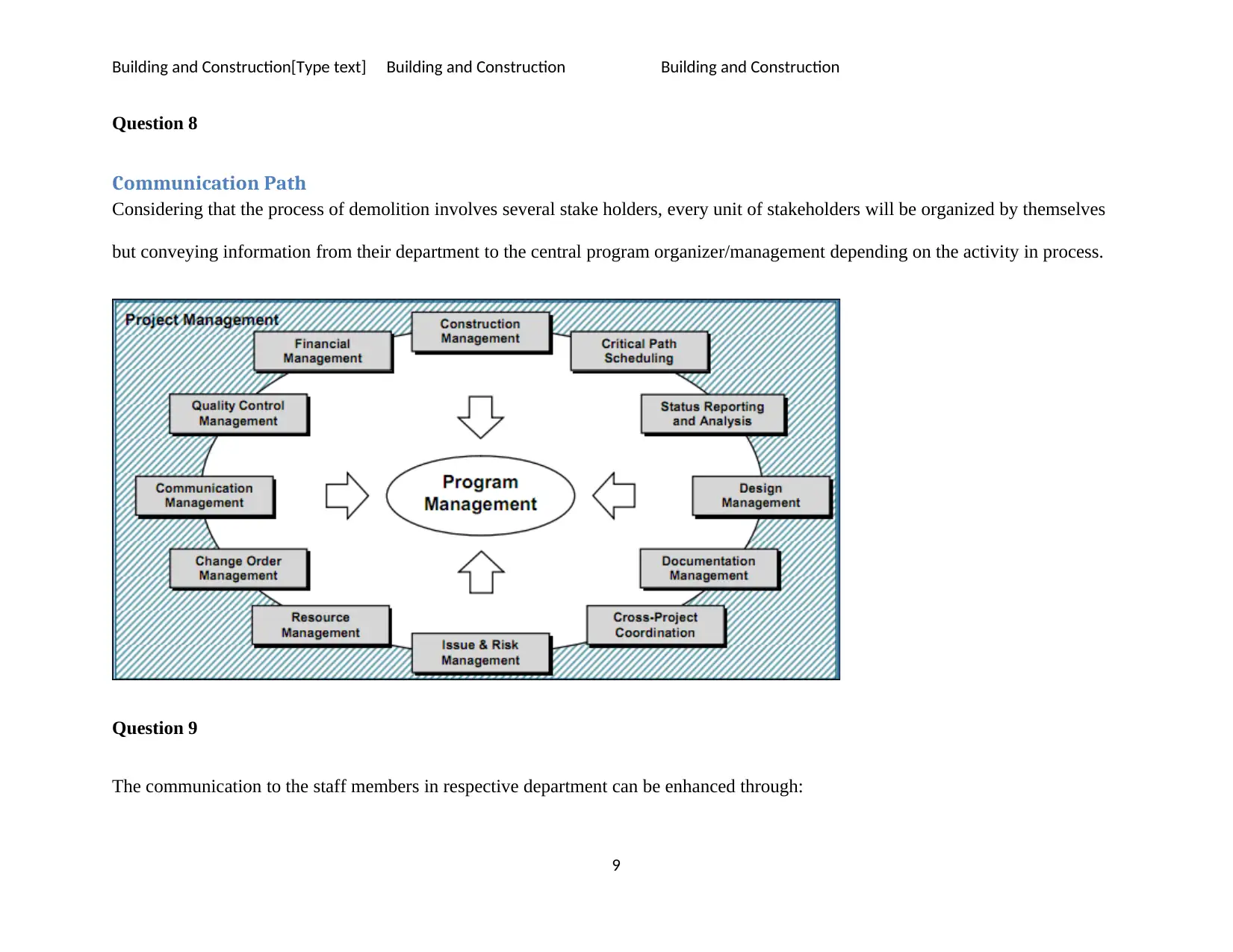
Building and Construction[Type text] Building and Construction Building and Construction
Question 8
Communication Path
Considering that the process of demolition involves several stake holders, every unit of stakeholders will be organized by themselves
but conveying information from their department to the central program organizer/management depending on the activity in process.
Question 9
The communication to the staff members in respective department can be enhanced through:
9
Question 8
Communication Path
Considering that the process of demolition involves several stake holders, every unit of stakeholders will be organized by themselves
but conveying information from their department to the central program organizer/management depending on the activity in process.
Question 9
The communication to the staff members in respective department can be enhanced through:
9
⊘ This is a preview!⊘
Do you want full access?
Subscribe today to unlock all pages.

Trusted by 1+ million students worldwide
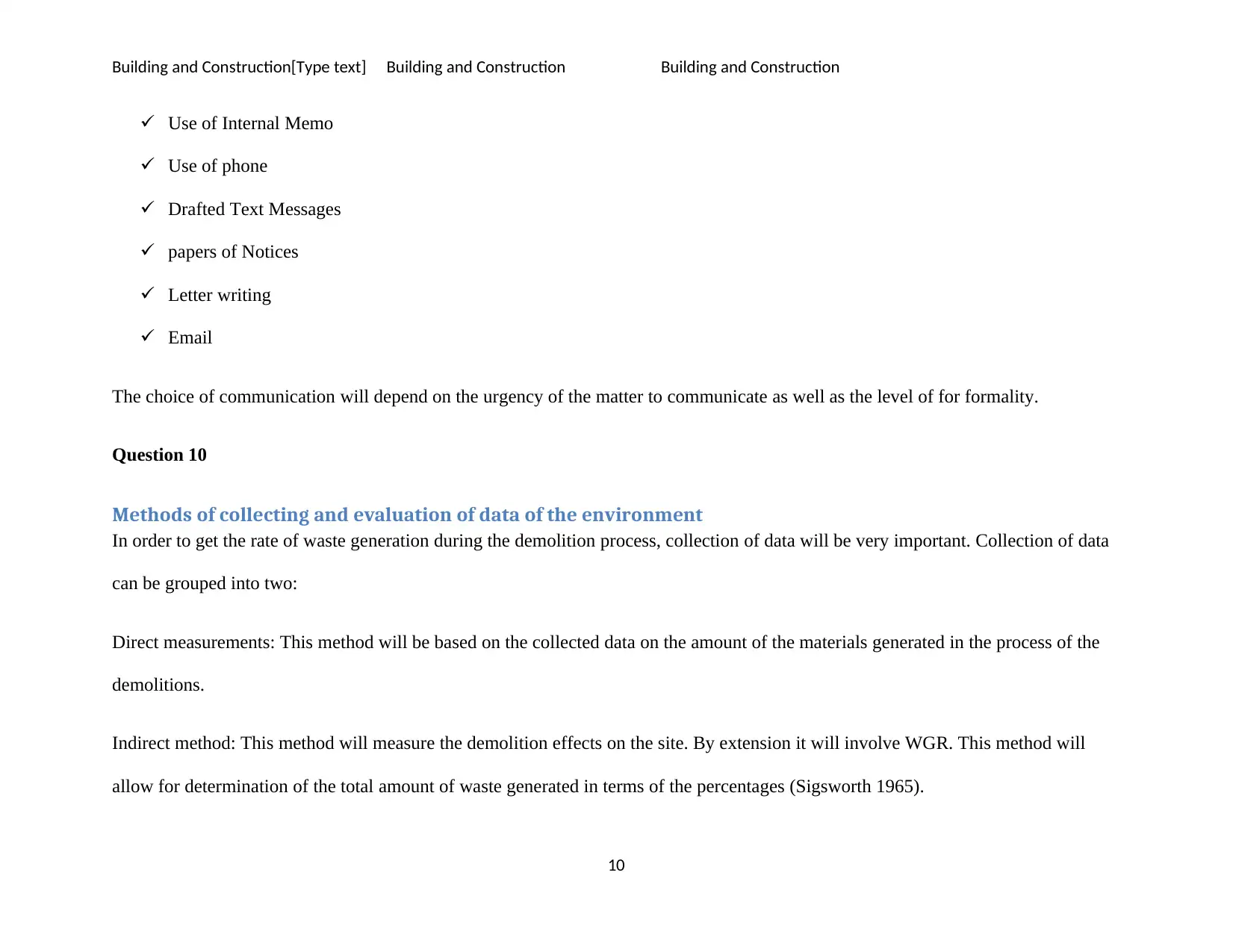
Building and Construction[Type text] Building and Construction Building and Construction
Use of Internal Memo
Use of phone
Drafted Text Messages
papers of Notices
Letter writing
Email
The choice of communication will depend on the urgency of the matter to communicate as well as the level of for formality.
Question 10
Methods of collecting and evaluation of data of the environment
In order to get the rate of waste generation during the demolition process, collection of data will be very important. Collection of data
can be grouped into two:
Direct measurements: This method will be based on the collected data on the amount of the materials generated in the process of the
demolitions.
Indirect method: This method will measure the demolition effects on the site. By extension it will involve WGR. This method will
allow for determination of the total amount of waste generated in terms of the percentages (Sigsworth 1965).
10
Use of Internal Memo
Use of phone
Drafted Text Messages
papers of Notices
Letter writing
The choice of communication will depend on the urgency of the matter to communicate as well as the level of for formality.
Question 10
Methods of collecting and evaluation of data of the environment
In order to get the rate of waste generation during the demolition process, collection of data will be very important. Collection of data
can be grouped into two:
Direct measurements: This method will be based on the collected data on the amount of the materials generated in the process of the
demolitions.
Indirect method: This method will measure the demolition effects on the site. By extension it will involve WGR. This method will
allow for determination of the total amount of waste generated in terms of the percentages (Sigsworth 1965).
10
Paraphrase This Document
Need a fresh take? Get an instant paraphrase of this document with our AI Paraphraser
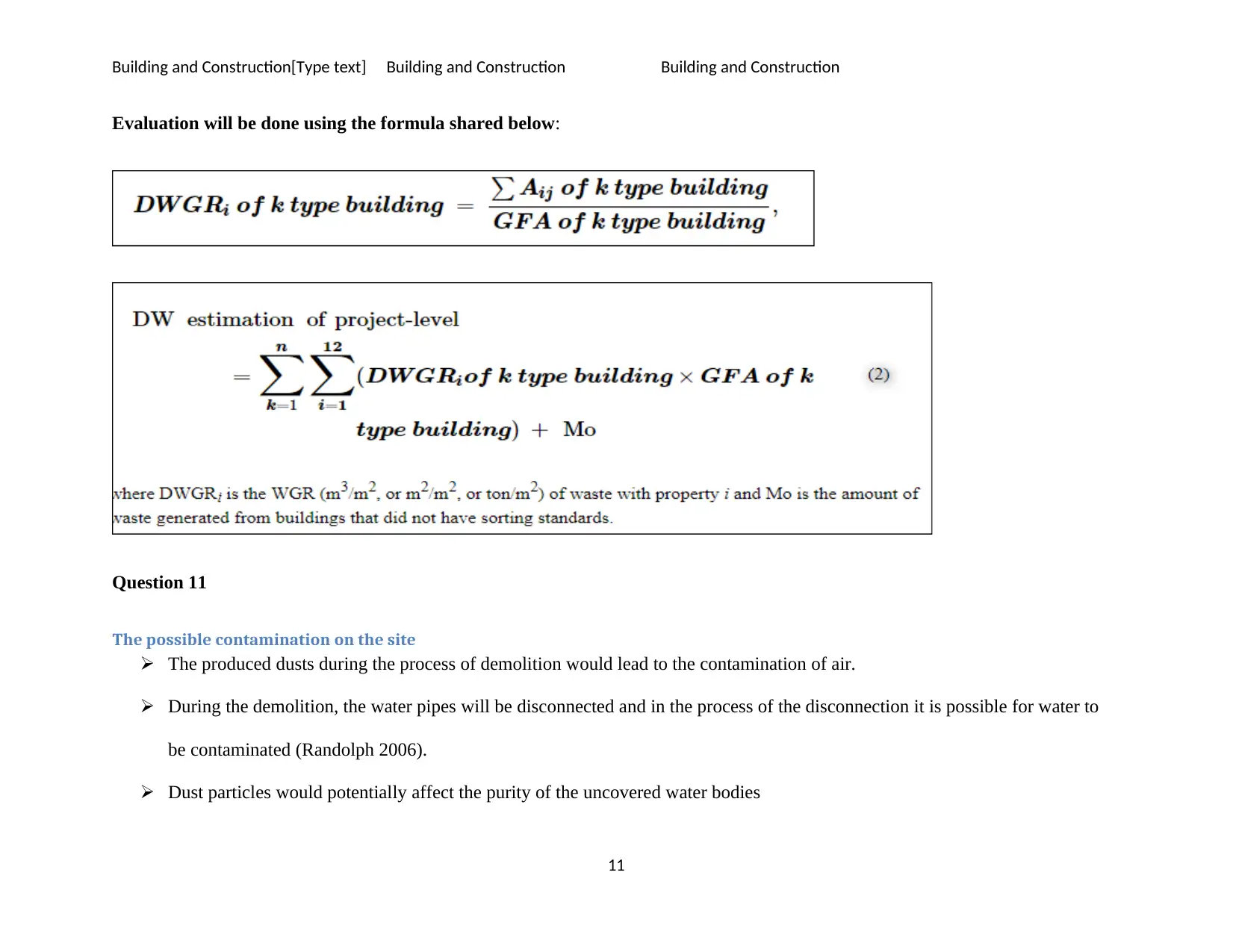
Building and Construction[Type text] Building and Construction Building and Construction
Evaluation will be done using the formula shared below:
Question 11
The possible contamination on the site
The produced dusts during the process of demolition would lead to the contamination of air.
During the demolition, the water pipes will be disconnected and in the process of the disconnection it is possible for water to
be contaminated (Randolph 2006).
Dust particles would potentially affect the purity of the uncovered water bodies
11
Evaluation will be done using the formula shared below:
Question 11
The possible contamination on the site
The produced dusts during the process of demolition would lead to the contamination of air.
During the demolition, the water pipes will be disconnected and in the process of the disconnection it is possible for water to
be contaminated (Randolph 2006).
Dust particles would potentially affect the purity of the uncovered water bodies
11
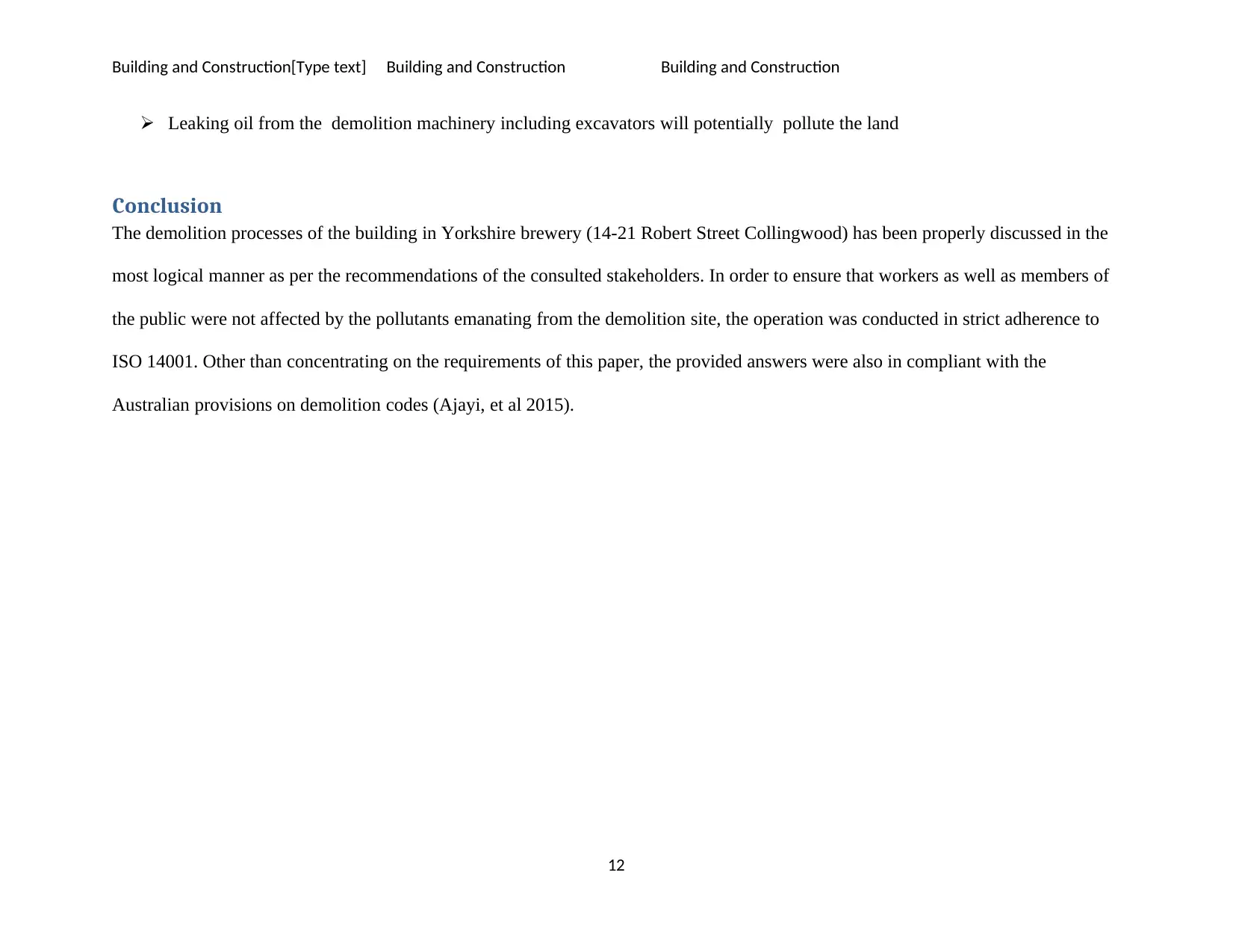
Building and Construction[Type text] Building and Construction Building and Construction
Leaking oil from the demolition machinery including excavators will potentially pollute the land
Conclusion
The demolition processes of the building in Yorkshire brewery (14-21 Robert Street Collingwood) has been properly discussed in the
most logical manner as per the recommendations of the consulted stakeholders. In order to ensure that workers as well as members of
the public were not affected by the pollutants emanating from the demolition site, the operation was conducted in strict adherence to
ISO 14001. Other than concentrating on the requirements of this paper, the provided answers were also in compliant with the
Australian provisions on demolition codes (Ajayi, et al 2015).
12
Leaking oil from the demolition machinery including excavators will potentially pollute the land
Conclusion
The demolition processes of the building in Yorkshire brewery (14-21 Robert Street Collingwood) has been properly discussed in the
most logical manner as per the recommendations of the consulted stakeholders. In order to ensure that workers as well as members of
the public were not affected by the pollutants emanating from the demolition site, the operation was conducted in strict adherence to
ISO 14001. Other than concentrating on the requirements of this paper, the provided answers were also in compliant with the
Australian provisions on demolition codes (Ajayi, et al 2015).
12
⊘ This is a preview!⊘
Do you want full access?
Subscribe today to unlock all pages.

Trusted by 1+ million students worldwide
1 out of 15
Your All-in-One AI-Powered Toolkit for Academic Success.
+13062052269
info@desklib.com
Available 24*7 on WhatsApp / Email
![[object Object]](/_next/static/media/star-bottom.7253800d.svg)
Unlock your academic potential
Copyright © 2020–2025 A2Z Services. All Rights Reserved. Developed and managed by ZUCOL.
